Arab revolt: social media and the people’s revolution
Country by country Channel 4 News unpicks the key social media elements of revolt throughout the Middle East and assesses how internet communication helped awaken online youth activism.
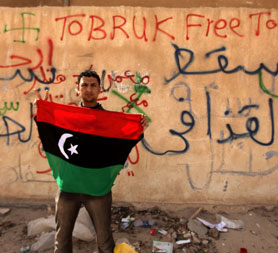
Two months ago a young Tunisian lit a match which set the Arab world on fire.
The self-immolation of a 23-year-old in the town of Sidi Bouzid led to the downfall of the Tunisian President Zine al-Abedine Ben Ali, which in turn mobilised events which toppled Egypt’s Hosni Mubarak, while inspiring hundreds of thousands to take to the streets across the Middle East.
While demonstrations in the Arab world and further afield seem to have been ignited by “people power”, the influence of the internet on young revolutionaries is undeniable.
Libya and the rise of #Feb17
Amid a near-total media blackout the internet has played a major role in distributing video, pictures and information about the ongoing unrest in Libya.
Footage has emerged online of the violent clashes between anti-government protesters and the security forces, while countless video clips have been uploaded showing the chaos which appears to be spreading across Libya.
While rumour can be widespread, accurate and detailed information has filtered out on social networking sites such as Facebook and Twitter, with users across the globe following minute-by-minute accounts of the latest events.
My name is freedom. Born in Tunisia, raised in Egypt, studied in Yemen, fought in Libya and I’ll grow up in the Arab world. @AliTweel, Twitter
Omar Amer, the UK head of the Libyan Youth Movement which is based in Manchester, told Channel 4 News that social media had become a “very important factor” in the real-time communication of events across the Middle East.
“I can call Benghazi or Tripoli and obtain accurate information from people on the ground and then report it straight on Twitter to thousands of people,” the 24-year-old told Channel 4 News.
“There are no more ‘Chinese whispers’ – accurate information is spreading real-time.”
On the micro-blogging site, Twitter, the hashtag #Feb17 has categorised the movement and given a fresh identify to the Libyan protests amid unrest across the Arab world.
#Feb17 isn’t just the date the Libyan movement began this year, it is also symbolic for activists. On 17 February 2006 security forces killed at least a dozen protesters in Tripoli, while the following year 14 activists were detained for calling for action on the same day.
“There are pros and cons to #Feb17,” Omar Amer – who’s family are from a Benghazi tribe – told Channel 4 News.
“We had it in the early stages of the Egyptian revolution and have used it to push information online. But it also allowed Colonel Gaddafi to prepare by mobilising forces in eastern Libya.”
Websites inspired by #Feb17 have spread online, while the main Facebook page, where activists discuss when and where to protest, has attracted more than 82,000 members.
An Arabic news group on Facebook – RNN Libya – receives another 22,000 members.
Another key website dedicated to the cause of the protesters – http://www.libyafeb17.com/ – posts the latest news updates in English to appeal to a wider global audience, which has been key for online activists.
While many young Libyans have been frustrated by the slow response of foreign governments, social media has created an international show of solidarity.
“We’ve received overwhelming support, which has allowed all of the people in the region to come together,” Omar told Channel 4 News. “And it’s not just support from Tunisia and Egypt, it’s from the United States and beyond.”
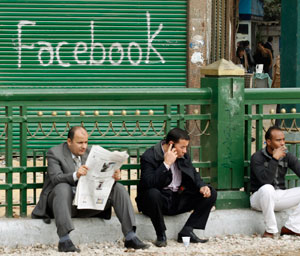
For the Libyan Youth Movement it was the events in Tunisia which led the way to revolt and spread of online information, while Egypt – described in the region at “the mother of the world” – meant change was coming to Libya.
Omar says it was the story of what happened in Sidi Bouzid, Tunisia, which “opened the door for peaceful protests”.
“The Sidi Bouzid picture spread like wildfire on the internet. Everyone could see what happened and then they organised the protests via social media. Everyone was informed – straightaway it was right there on your homepage.”
Tunisia: #SidiBouzid – roots of the revolution
For online activists it started with #SidiBouzid. After Mohammed Bouazizi set himself on fire in the Tunisian town in protest against youth unemployment, his story stretched through the blogosphere and ended up as a Twitter hashtag which spread through the Middle East.
While the Tunisian government blocked websites and arrested activists, the tech-savvy generation hit back by sharing information through blogs and news sites, some which are run by expatriates, such as Nawaat which documented the hour-by-hour events of the revolt.
In early January – just 10 days before President Ben Ali was toppled – blogger Lina Ben Mhenni told Channel 4 News there was “no online organisation”, but young people took advantage of an already-vibrant web scene to spread their message.
“The official media does not cover what is really happening in Tunisia, so bloggers and online activists try to do this,” she said.
“Bloggers and online activists share everything on their blogs, Facebook and Twitter. Despite the censorship and the government hacking of emails and Facebook profiles, we manage to share information by using proxies and circumvention tools.”
Chinese push for 'Jasmine revolution'
A month on from the moment President Ben Ali fled Tunisia to Saudi Arabia, Chinese officials have cracked down on the spread of online dissent by apparently escalating internet censors.
Searches for terms such as "Egypt" and "Jasmine revolution" - coined from the Tunisian revolt - have been blocked on Chinese micro-blogging sites such as Weibo.
Web blocks on other sites such as Twitter and US-based news site Boxun mean only Chinese people using proxies would have been able to see a recent anonymous statement posted online calling for people to take to the streets.
Such was the influence of the young, who used the internet to debate once forbidden issues, influential Tunisian blogger Slim Amamou – who was detained by the authorities for more than a week during the uprising – was invited into the government to work as Secretary of State for Youth Affairs following the revolution.
But while the Tunisian leader fell, the world watched – and that included Egyptian activists who had been using the internet as a tool of free speech, and now saw that the “fear had been broken”.
Egypt: #Jan25 and Wael Ghonim
Despite internet censorship Egypt boasts a vibrant blogosphere, with many influential writers using the internet as a platform for freedom of speech.
When young Egyptian Khaled Said was beaten to death by police in June 2010, online activists began protest groups with Khaled as their “martyr” and online cause celebre.
Facebook page “We are all Khaled Said“, along with other activist groups such as the April 6 Movement, proved instrumental in the Egyptian uprising.
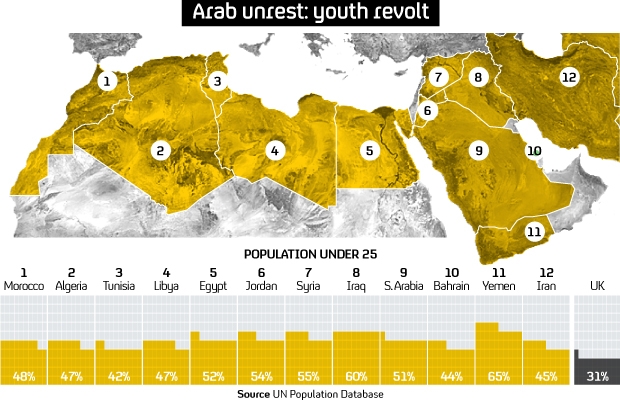
The Arabic version of the Facebook page was organised by an anonymous activist who was later revealed as Google executive Wael Ghonim.
After watching the fall of Ben Ali, Wael called for young Egyptians to take to the streets on 25 January, commemorated locally as National Police Day.
As video and pictures were posted online, the date became an online category for the protesters, immortalised in the Twitter hashtag #Jan25.
Weeks after the initial protests social media networks were awash with the #Jan25 tag, which became an effective way to group together online information about the protests.
The use of a date stamp would later be used throughout different countries in the Middle East to signify individual unrest.
As violence flared in some Egyptian cities during the revolt, social media was used to circulate pleas for medical aid and even tips of how to create home-made tear gas masks.
During the unprecedented protests across Egypt, a number of activists and bloggers were being hunted down and arrested for inciting revolt – including Wael who was held for 12 days. Realising the importance of the media war, protesters have fought back, broadcasting information on the internet 24 hours a day.
Groups of demonstrators were pictured setting up communal ‘online hubs’ near Tahrir Square, the focus for protests in the capital, where information was filmed on the streets and then uploaded online.
Such was the influence of social networking, it was later reported that one Egyptian man called his newly-born child “Facebook”.
Yemen youth movement
After the fall of Ben Ali in Tunisia and Mubarak in Egypt, many young people in Yemen felt motivated to fight for change, and the role of social media played a crucial part.
“The events in Tunisia and Egypt inspired the whole region, they made us realize that we don’t have to live with all the problems we’re having, and change is indeed possible,” internet activist Ala’a Jarban, 21 told Channel 4 News.
“Facebook and social media are playing a major role in all changes and revolutions happening in the Arab region. I know lots of people who didn’t use Facebook and they asked me for help to join in. I even did small workshops to new users of Facebook and Twitter.”
Ala’a says dozens of Facebook groups and websites sprang up spontaneously as unrest began to spread across the Arab world, all working to mobilise people.
The ‘Yemeni Anger Revolution’ group has almost 20,000 members on Facebook, and although only a minority of the population search the internet, others are then encouraged to get involved via traditional methods of leaflets and SMS text messaging.
While broadcasting videos, pictures and news about the protests and sit-ins at universities in the capital, the Yemeni international community help by pushing information out on a global scale.
“Many expatriate Yemenis gave us their numbers in case of internet shut-down, to help us sharing news about Yemen. Many of them help us tweeting and retweeting news, and also link us with the international media,” Ala’a tells Channel 4 News.
“Also Yemenis in different countries have started organizing protests in solidarity with the pro-change movement in Yemen.”
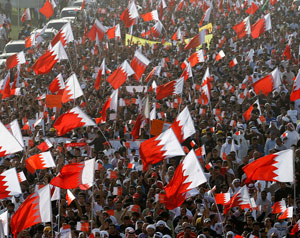
Bahrain: #Feb14
The internet has also proved to be an important tool for the masses camped out on Bahrain’s Pearl Square, in the capital Manama.
As in Egypt, many of those with the latest mobile phones used live web streaming devices to broadcast images directly from the protests. Sites such as Ustream, Livestream and Bambuser have enabled young protesters to take to the internet and filming live, while simultaneously taking part in the protests.
After live footage of the protests emerged online the Bahraini authorities sought to end their influence by blocking many of the websites such as Bambuser. Users were individually censored before the entire site was taken down inside Bahrain.
Many online activists however would not be silenced so easily. On Twitter the hashtag #Feb14 – the first day of the protests – became the identity of the Bahrain action, while video and pictures were uploaded through other means.
Facebook yet again also provided a platform for debate and mobilisation, and blog site Global Voices collated the information and documented the latest news coming out of the country.
After police stormed the protest camp in central Manama, clips appeared on YouTube of the injured in hospital, while rights activists such as Maryam Alkhawaja tweeted about her experiences and documented the deaths of demonstrators.
Algeria: Facebook block
Algeria is no stranger to unrest with violence erupting periodically in parts of the capital and other cities around the country for at least two years.
Last week the authorities were accused of blocking access to the internet during protests organised largely online by the National Co-ordination for Change and Democracy.
Rachid Salem from the group said the authorities had targeted Facebook groups first, limiting access and deleting accounts.
Despite the attempts to limit access, protests continues to spread in Algeria, with demonstrators resulting to word of mouth.
On Thursday the country lifted a 19-year state of emergency in a concession to opposition protesters calling for change.
Morocco: blog freedom
In Morocco, which enjoys wider freedoms than many of its north African neighbours, social media has been used as a tool for free debate for a number of years.
Facebook group “Movement of Freedom and Democracy” has attracted more than 89,000 members. Its founder Antid Rachid Spirit-Zata tells Channel 4 News that Morocco’s technologically-advanced youth use the medium as a modern medium of communication. Facebook itself is an easy platform for expression and debate, Rachid says, while also a means to organise peaceful protest.
“We were using Facebook before what happened in Tunisia and Egypt and have had some fierce discussions concerning freedom of speech and expression.
“We use it to argue with Islamist fanatics and to speak to them about their ideals and defend our ideas, multiculturalism, co-existence and national unity”.
Rachid tells Channel 4 News that young Moroccans were not in need of outlets for violent expression, but that Tunisia and Egypt prompted the youth to examine their own authority, with many calling for constitutional reform.

“Technology is peaceful by nature and it came from values that encourage dialogue, instead of violence and alienation.
“Violent protest is usually not fruitful, especially when you have a peaceful and modern medium you can express yourself and your problems.”
Iraq awakening: #Feb25
The ripples of the Arab revolt have been felt as far as Iraq, as many young people see it as a chance to express their opinions and protest against poverty and corruption.
The website and Facebook group Iraqi Streets for Change has been growing day by day and – although in its infancy – has published detailed protest maps and information for people keen to have their say.
The website’s founder and blogger Hamzoz told Channel 4 News the events in Tunisia and Egypt inspired young Iraqis to communicate their opinions.
“Young people are excited to participate in the reform process of the Iraqi regime,” Hamzoz told Channel 4 News.
“The impact of Tunisia and Egypt has reflected on the youth of Iraq who want to express their opinions through the means of social communication.”
Hayder and other online activists use their own Twitter tag #iq4c, but also the #feb25 date stamp as they know they can reach a larger audience by associating their cause with the other revolts.
“I’ve spoken to my friends in Tunisia and Egypt about tips for organising ourselves in similar demonstrations”, Hamzoz said. “I also train young Iraqis on how to use maps.”
Despite receiving threats to stop writing, Hayder says he uses the internet to speak freely and is not afraid.
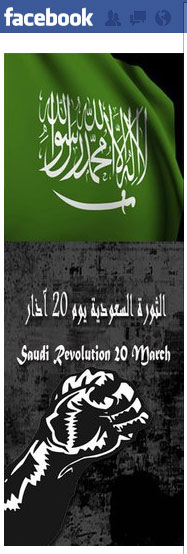
Syria: day of rage
In Syria, bloggers have a reason to fear the authorities. Earlier this month 19-year-old Tal al-Mallohi was jailed for five years for “spying”.
A court in Damascus found the teenager guilty of “revealing information to a foreign country”. Her blog includes poetry and commentary on the suffering of Palestinians.
While Syria recently lifted its ban on Facebook and YouTube after a three year block, many websites remain unavailable and the internet is closely watched by the authorities.
Channel 4 News attempted to contact a number of Syrian bloggers, but many said they were too afraid to have their comments published, even under anonymity.
Despite the crackdown, which affects many countries throughout the Middle East, Facebook group “The Syrian Revolution 2011” has received more than 24,000 followers and posts include information about the latest gatherings.
And as with many online pages, the site is also linked to the key international groups that called for an end to regimes in Tunisia and Egypt.
A number of Facebook pages have also been set up demanding the release of Tal al-Mallohi.
Saudi Arabia: #Mar20
Online activists have had similar problems in Saudi Arabia, where the main Facebook page organising protests was blocked on Thursday.
The administrator of “Saudi Revolution 20 March” told Channel 4 News the site had been set up in the wake of the Tunisian revolution, with the proposed protest date becoming the #Mar20 hash tag which has helped sell the protest across online networks.
But activists face a difficult online battle as the authorities try to control information.
Tamer – who’s name has been changed to protect his identity – said he believed pro-regime members were planted by the authorities to deliberately create division among the group.
“The Saudi movement was inspired by Tunisia and Egypt and we are in contact with a lot of people from those countries who advise us on steps to take. But here the situation is worse.
“The authorities are controlling the internet and creating fights between people online between Sunni and Shi’a – the people need to come together to create a successful revolution.”
Currently three dates of protest have been suggested as web-savvy activists try to mobilise the youth to take action.
Heated debates are currently raging as to whether demonstrators should take to the streets the 6th, 11th and/or 20th of March.